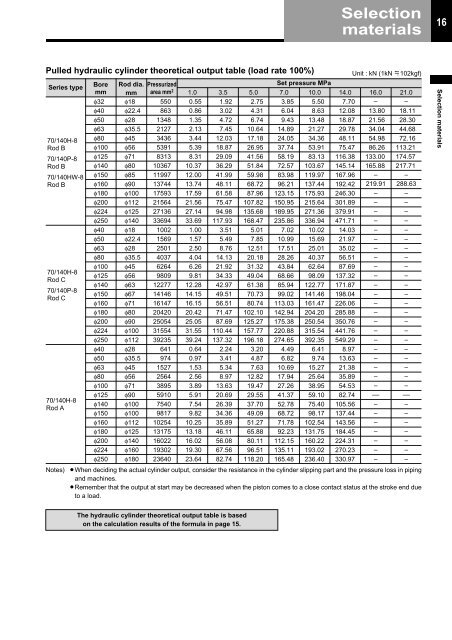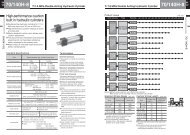70/140H-8 Series (2310KB) - TAIYO
70/140H-8 Series (2310KB) - TAIYO
70/140H-8 Series (2310KB) - TAIYO
Create successful ePaper yourself
Turn your PDF publications into a flip-book with our unique Google optimized e-Paper software.
9<br />
For safe use<br />
For safe use<br />
(General precautions)<br />
● When the weight of the cylinder exceeds 15 kg, use<br />
a lifting tool or a carrier.<br />
● Keep good arrangement and cleanliness of the<br />
working site. The slippage due to oil leak may lead<br />
to a turnover. Keep clean, and try to find oil leak<br />
soon.<br />
● When mounting a cylinder, be sure to perform<br />
centering. Otherwise, the rod and tube may be disordered,<br />
causing the wear and breakage of the tube<br />
inside, surfaces of bush or rod, and packings. The<br />
unsmooth movement of the rod may also occur.<br />
● When using the external guide, adjust it so that it is<br />
not disordered in any position of the stroke, or<br />
connect considering the connection of the rod end<br />
and loads.<br />
● Use the working oil applicable to the material of the<br />
packings for the cylinder, and DO NOT mix working<br />
oil of other types.<br />
The recommended cleanliness of working oil is the<br />
grade NAS 10 or higher.<br />
(Piping)<br />
● Perform flushing before piping to reduce chips,<br />
cutting oil, dusts in the pipes.<br />
Remove the cylinder before flushing to avoid the<br />
ingress of flushing fluid into the cylinder.<br />
● Application of sealing tape<br />
When connecting pipings with sealing tape, apply<br />
the tape with one or two threads on the thread tip<br />
left.<br />
When screwing pipings and fittings in, take care to<br />
avoid the ingress of chips or sealing material of the<br />
piping screw into the piping. When applying liquid<br />
packing to the fittings, similarly pay attention.<br />
Scraps of sealing tape or chips may cause oil leak<br />
or other malfunctions.<br />
● When piping, take care to avoid air accumulation.<br />
● When using steel pipe for piping, select proper size<br />
and avoid rusts and corrosion.<br />
● If welding is required for piping, ground in other<br />
safety location to avoid ground current in the<br />
cylinder. The ground current between the bush and<br />
rod, cylinder tube and piston may lead to a spark,<br />
causing the damages on surfaces and malfunctions.<br />
Caution<br />
(Adjustment of cushion and air vent)<br />
● The excessive loosening of the check plug when<br />
venting air may lead to coming-off or jumping of the<br />
check plug from the cylinder, causing spouted oil.<br />
● Feed the oil with a low pressure (the pressure<br />
with which the cylinder can move at the low<br />
speed of approx. 10 mm/s), and loosen the check<br />
plug by one or two turns (counterclockwise) to<br />
vent air in the oil from the check valve.<br />
● The initial increase of the piston speed during the<br />
cushion adjustment may lead to abnormal surge<br />
pressures, causing the damaged cylinder or<br />
machines.<br />
● Slowly increase the piston speed from the low<br />
speed of approx. 50 mm/s or lower to adjust the<br />
cushion.<br />
When adjusting the cushion, adjust depending on<br />
matters to be driven (loads).<br />
● If the cushioning is excessive, the cylinder may<br />
not reach the stroke end due to the contained oil<br />
in the cushion.<br />
(Notes on trial run and operation)<br />
● Ensure that the machines and devices are correctly<br />
mounted. DO NOT start without the confirmation of<br />
no oil leak.<br />
● Run with the minimum pressure to start the piston<br />
rod (the piston speed must be approx. 50 mm/s or<br />
lower), and ensure that it is worked smoothly.




